

 It’s time for California, long a leader in green energy investment, to take another big step forward on the environment and job creation.
It’s time for California, long a leader in green energy investment, to take another big step forward on the environment and job creation.
When Californians passed Proposition 39 last year, they voted for more carbon reduction, school improvements and jobs – all through a five-year, $2.5 billion program using revenues from newly closed tax loopholes to pay for investments in energy efficiency and renewable energy. Now state policymakers are making critical decisions as they craft the guidelines for this massive new investment.
School facilities are the primary target of Proposition 39 retrofitting efforts. But if the measure is going to deliver on its promises of carbon reduction, healthier schools and neighborhoods, long-term career opportunities and a timely economic boost for communities that need it the most, the proposition needs to be implemented right.
I’ve been studying the green jobs sector since its early days, and my research and observations suggest some important recommendations.
» Read more about: Going Green and Growing Jobs, the Right Way »
 An ounce of prevention is worth a pound of cure. A stitch in time saves nine. One dollar spent on contraception saves three on pregnancy and newborn care, and that is just the beginning.
An ounce of prevention is worth a pound of cure. A stitch in time saves nine. One dollar spent on contraception saves three on pregnancy and newborn care, and that is just the beginning.
Nationally, we spend 11 billion taxpayer dollars a year on unintended pregnancies. But who’s counting? Automatic cuts built into the sequester slashed $86 million from family planning and reproductive health care for poor women. But that is not enough for Congressional Republicans, who are trying yet again to roll back the contraceptive mandate. If there ever was an indication that they are more interested in ideology than balanced budgets, this is it.
Research published this fall showed that effective, affordable, accessible contraception dramatically drops the rate of unintended pregnancy and related public health costs. In the study, whose co-author explained that it was essentially designed to mimic what Obamacare would have provided,
» Read more about: Contraceptive Mandate: Another Budget Hostage »
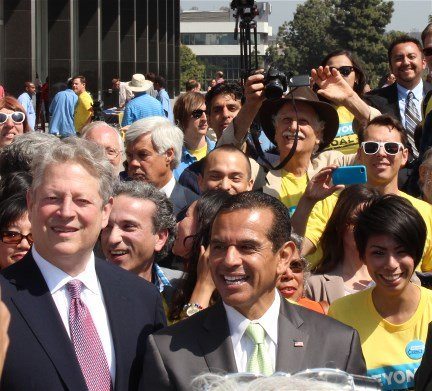

Last week I stood with hundreds of proud Angelenos outside the Department of Water and Power headquarters in downtown Los Angeles to celebrate a momentous announcement for the city and our environment. Mayor Antonio Villaraigosa proclaimed that Los Angeles will be completely off of coal power before 2025.
It will be a monumental shift.
“It took one hundred years to build up the power supply the DWP has today,” the Mayor explained, “but in a decade and a half, we’re going to replace 70 percent of it.” “Right now, 40 percent of our power comes from coal plants. But by 2025, that number will be zero.”
With the spotlight on our city, we were joined by national environmental leaders such as former Vice President Al Gore and Sierra Club Executive Director Mike Brune.
“This is a really big deal,” Gore said emphatically. “Americans worry that government is broken,
» Read more about: L.A.’s Big Energy Shift: Goodbye Dirty Coal »
Figures are from 2009 through March, 2013. Sources: Parent Revolution; foundation tax returns; foundation grant reports. See “Public Schools, Private Agendas: Parent Revolution.”


If you’re like me, right now you may be scrambling to stock up on all of your Passover essentials. So what if I told you that you could get 12 boxes of matzah – more than enough to cover the eight days and nights of breadless revelry – for just over $40 bucks?
Ah, but there’s a catch: You’ll have to buy this miracle matzah pak at Walmart. Moral dilemma? You bet.
Last year we provided a short list of reasons you might want to think twice about a Walmart matzah binge. We wish we could report that Walmart had cleaned up its act since then, but alas, the world’s largest retailer has racked up a series of alleged corporate crimes and indiscretions that would make a pharaoh blush.
So before you succumb to those everyday low prices, here are five more reasons not to buy matzah at Walmart:
1) Hunger Strike: Remember those passages in the haggadah about the bread of affliction?
» Read more about: Five New Reasons Not to Buy Matzah at Walmart »
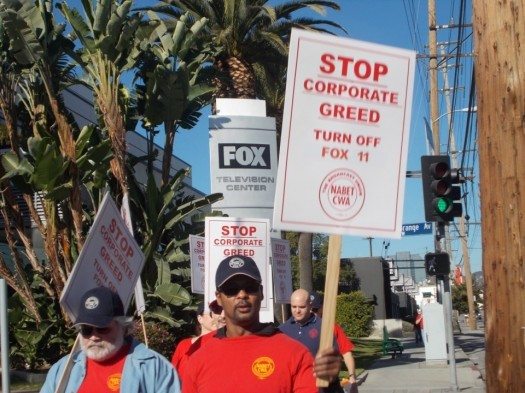

 “What do ex-cons and trade unions in California have in common?” With those words, KTTV Fox 11 Vice-President and General Manager Kevin Hale begins his latest editorial criticizing California’s High Speed Rail Project, specifically a hiring policy that gives preferential treatment to disadvantaged workers.
“What do ex-cons and trade unions in California have in common?” With those words, KTTV Fox 11 Vice-President and General Manager Kevin Hale begins his latest editorial criticizing California’s High Speed Rail Project, specifically a hiring policy that gives preferential treatment to disadvantaged workers.
“They are defining disadvantaged workers as former criminals and some union workers,” Hale says.
Mr. Hale is certainly entitled to his opinion about the bullet train, but when he starts lumping together criminals and union workers, I have to object.
His true anti-union colors are showing with that distortion of the facts.
Mr. Hale fails to mention in his editorial that the High Speed Rail Project also gives preferential treatment to several other groups, including veterans, single parents, former foster children, high school dropouts and the homeless.
But you’ll notice Mr. Hale doesn’t associate veterans, foster children or single parents with former criminals.


 A new economy is coming. While Wall Street banks are on a trend of corporate mergers and acquisitions, Main Street businesses are generating community wealth while undergoing a transition of their own. Traditional companies are becoming worker cooperatives, both to sustain during tough economic times and because years of success have enabled these companies to reward their workers. State and local governments are beginning to get wise to this trend, too, adding legislative influence to an already vibrant movement.
A new economy is coming. While Wall Street banks are on a trend of corporate mergers and acquisitions, Main Street businesses are generating community wealth while undergoing a transition of their own. Traditional companies are becoming worker cooperatives, both to sustain during tough economic times and because years of success have enabled these companies to reward their workers. State and local governments are beginning to get wise to this trend, too, adding legislative influence to an already vibrant movement.
Take the example of Zingerman’s Community of Businesses, an umbrella company that runs a fleet of food service outfits based in Ann Arbor, Michigan. Over the course of more than 30 years, Zingerman’s has become a statewide destination for food lovers, and their owners have become business community luminaries. Nearly 600 employees work in the eight distinct businesses that comprise the Zingerman’s Community, generating annual revenues of $46 million.


When voters approved Proposition 39 last November, they were voting for good clean-energy jobs, and energy efficiency projects in public schools and other public facilities that would save taxpayers money.
The proposition closed a corporate tax loophole and will provide up to $550 million annually in savings that, in the first four years, will go toward energy efficiency projects. An article that recently appeared in the industry press with the headline, “HVAC Contractor Ordered to Pay Nearly $1 Million for Violating Labor Law,” offers a cautionary tale for state lawmakers who are now considering how to spend those funds.
The article reports that California labor commissioner Julie Su ordered Ace Cooling & Heating Corporation, a contractor that installs heating and cooling systems for buildings, to pay nearly a million dollars in fines and wages to 10 employees for their work on a modernization project at El Camino Community College in Torrance.
» Read more about: Wage Theft Case Shows the Need for Workforce Standards »
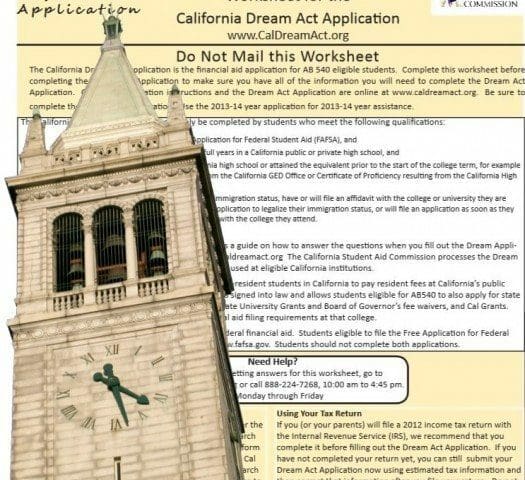

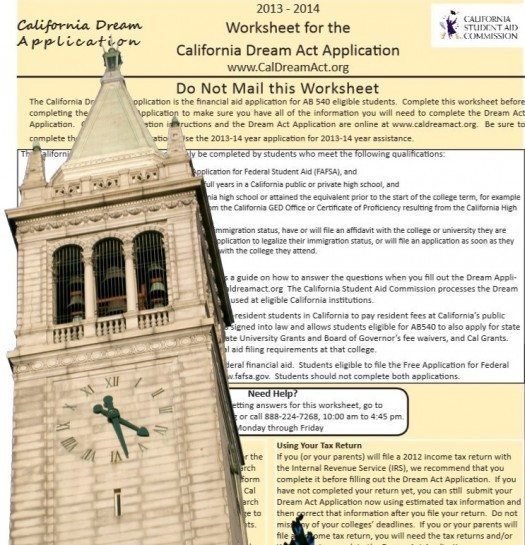 The California Dream Act went into effect on Jan. 1, allowing thousands of immigrant students a chance for the first time to apply for state financial aid to help pay tuition at state colleges and universities.
The California Dream Act went into effect on Jan. 1, allowing thousands of immigrant students a chance for the first time to apply for state financial aid to help pay tuition at state colleges and universities.
Within hours of going live, the online application system was overwhelmed by applicants and shut down.
“It was the first time the California Dream Act was implemented and we had some bugs,” said Patti Colston, a spokeswoman for the California Student Aid Commission.
“As soon as we found out, we contacted and notified students. To make sure their privacy was protected, we asked about 1,000 students to resubmit their applications,” she said, adding that no applications were lost.
By the March 2 deadline, 20,000 applications were received, said Colston. So far, 3,600 financial awards have been made to Dream Act-eligible students, averaging about $4,000 each. Applications are still being processed.
» Read more about: This Dream Is No Act — California Aids Immigrant Students »


Our Nation so richly endowed with natural resources and with a capable and industrious population should be able to devise ways and means of insuring to all our able-bodied working men and women a fair day’s pay for a fair day’s work. A self-supporting and self-respecting democracy can plead no justification for the existence of child labor, no economic reason for chiseling workers’ wages or stretching workers’ hours.
Enlightened business is learning that competition ought not to cause bad social consequences which inevitably react upon the profits of business itself. All but the hopelessly reactionary will agree that to conserve our primary resources of man power, government must have some control over maximum hours, minimum wages, the evil of child labor and the exploitation of unorganized labor. –FDR, May 1937
In his recent State of the Union address,
» Read more about: The Minimum Wage Offers the Working Poor Maximum Help »
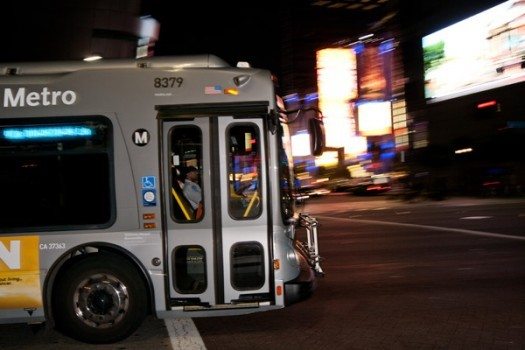

 The regional transportation authority for Los Angeles placed an order for 550 American-made buses last month, Huffington Post reported. The news comes at a time of presidential promises to both ramp up American manufacturing and rethink federal infrastructure spending.
The regional transportation authority for Los Angeles placed an order for 550 American-made buses last month, Huffington Post reported. The news comes at a time of presidential promises to both ramp up American manufacturing and rethink federal infrastructure spending.
The Los Angeles County Metropolitan Transportation Authority (L.A. Metro for short) struck a $305 million deal with a Canadian company, New Flyer Industries, to take charge on the creation of its new fleet of clean-fuel buses. The deal is unique in that it hinged on a commitment from the manufacturer to make the buses in the U.S. and create a certain number of quality jobs. (Most buses serving the U.S. are built outside of the country.)
Despite its base in Winnipeg, Manitoba, New Flyer Industries has factories at three different locations in the states of Minnesota and Indiana. It intends to expand operations at its manufacturing plant in St.
» Read more about: Stop Throwing American Manufacturing Jobs Under the Bus »


Even as the new documentary A Place at the Table highlights in heart-wrenching fashion the plight of 16 million U.S. children who don’t know where their next meal is coming from, some want to end a safety net that for decades has stood between some kids and a slow death from malnutrition – the school meal program. Think starvation can’t happen here, in one of the richest countries on earth? Think again. Not only could U.S. children starve without school meals, but not all that long ago, they did.
Terence Jeffrey, editor in chief of CNSnews.com, argues in an article entitled “Sixty-four Percent of Schoolchildren Fed on Federal Subsidies” that the federal school lunch program is “a weapon liberals employ in their war against the family.” This bizarre idea is based on data he presents which allegedly show a correlation between the increasing number of children eating government subsidized school meals since 1969,
» Read more about: Reporting on Hunger in Schools: Let Them Eat “Balance” »


Hundreds of Waste Management workers belonging to the International Longshore and Warehouse Union (ILWU) struck three facilities Friday morning, March 15, shutting down the company’s East Bay operation in for five hours. The successful job action was made possible by the support from hundreds of Teamster members who honored picket lines and refused to drive the company’s trucks that collect refuse and recycling early each morning from residential and industrial customers. Additional support came from members of the Machinists Union who honored picket lines by refusing to report for their maintenance and repair jobs during the strike.
ILWU members organized their picket lines beginning at 3 a.m. outside the company’s headquarters in Oakland, a recycling facility in San Leandro and the massive regional landfill in Livermore/Altamont. The job action was sparked by the company’s blatant law-breaking against employees, including retaliation that targeted immigrant workers.
In the days leading up to the strike,
» Read more about: ILWU: Waste Management Inc. Targets Immigrant Workers »


After the sequester cut teaching jobs, Head Start spots, senior food programs and access to nutrition assistance for over half a million women and their families, the GOP revealed its brand new short-term budget bill for 2013. Buried on page 221 is a curious clause banning federal funding to ACORN, an anti-poverty group.
The clause reads, “None of the funds made available in this Act may be distributed to the Association of Community Organizations for Reform Now (ACORN) or its subsidiaries or successors.”
But ACORN is long dead. Republican and right wing activists helped kill it in 2009 by smearing it with a video falsely edited to be deliberately misleading and stampeding the Democrats into a bill that stripped ACORN of all federal funds.
The bill that defunded ACORN in 2009 was broader – applying to “any organization” that has been charged with breaking federal or state election laws,
» Read more about: Congress Still Punishes ACORN & Rewards Amgen’s Fraud »


 “Our biggest problems over the next 10 years are not deficits,” the President told House Republicans Wednesday, according to those who attended the meeting.
“Our biggest problems over the next 10 years are not deficits,” the President told House Republicans Wednesday, according to those who attended the meeting.
The President needs to deliver the same message to the public, loudly and clearly. The biggest problems we face are unemployment, stagnant wages, slow growth and widening inequality — not deficits. The major goal must be to get jobs and wages back, not balance the budget.
Paul Ryan’s budget plan — essentially, the House Republican plan — is designed to lure the White House and Democrats, and the American public, into a debate over how to balance the federal budget in 10 years, not over whether it’s worth doing.
“This is an invitation,” Ryan explained when he unveiled the plan Tuesday. “Show us how to balance the budget. If you don’t like the way we’re proposing to balance our budget,
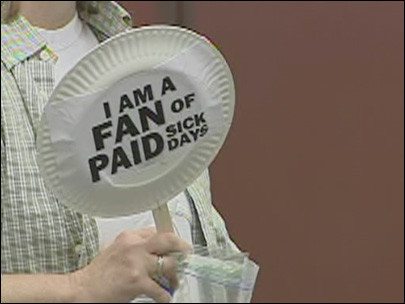

 In a growing sign of civic concern about the lack of employer-provided sick leave, Philadelphia’s city council voted Thursday morning to require most businesses to offer some form of the benefit to their workers. On Wednesday, Portland’s city council also voted to require private businesses to offer sick leave to their workers. The Portland council vote was unanimous; the Philadelphia vote was a veto-proof 11 to six.
In a growing sign of civic concern about the lack of employer-provided sick leave, Philadelphia’s city council voted Thursday morning to require most businesses to offer some form of the benefit to their workers. On Wednesday, Portland’s city council also voted to require private businesses to offer sick leave to their workers. The Portland council vote was unanimous; the Philadelphia vote was a veto-proof 11 to six.
A Los Angeles Times business-section story reported that, prior to the Portland passage, only three other U.S. cities have mandated that employers provide workers with sick leave. (The state of Connecticut also requires it.) However, all employers affected by living wage laws in Los Angeles and Long Beach are also obligated to offer sick leave benefits.
An awareness of links between the spread of workplace illnesses and the lack of paid sick time – which discourages ill workers from staying home —
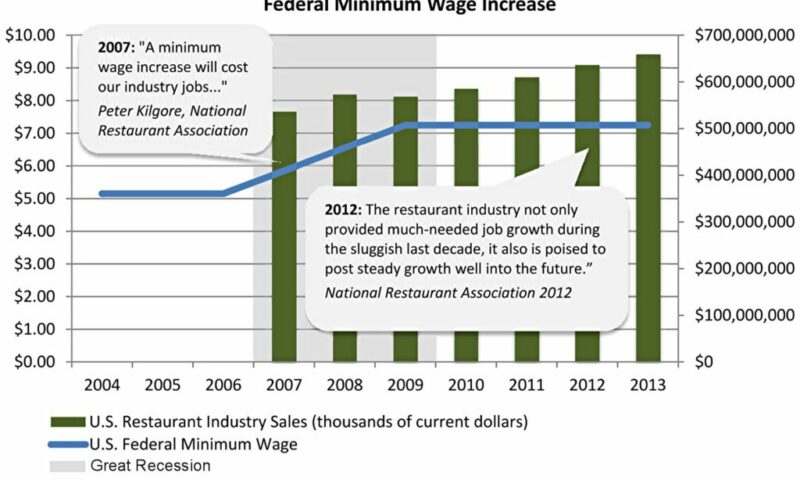
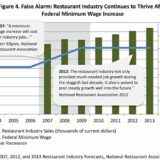
In her Congressional testimony from 1959, Eleanor Roosevelt noted the repetitive quality of objections raised by minimum wage opponents over the previous five decades. More than 50 years later, it appears that nothing has changed.
Our new report, published with the National Employment Law Project, documents the rhetorical onslaught launched by minimum wage opponents over the past 100 years. Rather than approaching these claims at face value, we step back and review how minimum wage opponents have presented their case through roughly a century’s worth of public statements, congressional testimonies, editorials, media interviews, and other public records, devoting a critical eye to the trajectory of these criticisms over time.
Sample quotes from Consider the Source: 100 Years of Broken-Record Opposition to the Minimum Wage:
1937
“Rome, 2,000 years ago, fell because the government began fixing the prices of services and commodities.
» Read more about: Minimum Wage Foes: Crying Wolf All the Way to the Bank »


 Last week’s headlines highlighted record prices for the Dow Jones stock market average. But who really wins when stock prices soar?
Last week’s headlines highlighted record prices for the Dow Jones stock market average. But who really wins when stock prices soar?
The biggest American winner was Rupert Murdoch, the boss of right-wing Fox News and a global media empire. He made $214.81 million in a single day, according to Forbes magazine. Mexican magnate Carlos Slim did better still, with a staggering $1.09 billion one-day increase in [his] wealth. They, plus the other 98 individuals on Bloomberg’s list of the world’s wealthiest people, made $28.7 billion in a single day.
But what about us? Here are some of the hard economic facts that really matter to the 99 Percent:
» Read more about: The Dow Is Up But the 99 Percent Are Down »
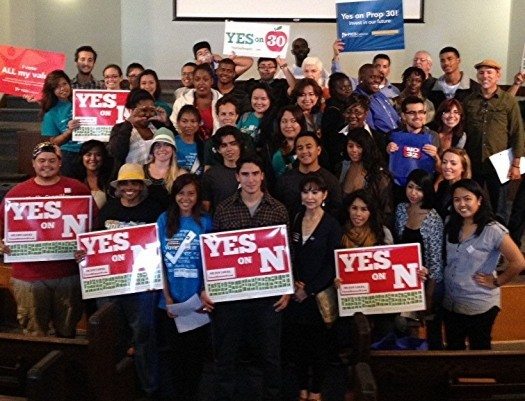

On Sunday the Los Angeles Times published a story about the important successes of campaigns to pass local minimum wage and living wage laws. However, while highlighting new developments that will impact local economies and the lives of workers, the Times missed the real story and forces behind this growing trend.
The piece focused on two ballot-box victories for living wage laws: a minimum wage for hotel workers in Long Beach and a citywide minimum wage increase in San Jose.
“The victories put these two California cities on the cusp of an emerging trend,” wrote Wesley Lowery. “Ballot initiatives, labor experts say, have the potential to rewrite labor’s playbook for how to win concessions from management.” Throughout the piece, Lowery presented the minimum wage ballot measures as a tactic put in place and managed from behind the scenes by labor leaders.
In fact,
» Read more about: L.A. Times Misses the Story Behind Living Wage Campaigns »
In the previous week we reposted this fact-packed, viral video (more than four million views at last count) about economic inequality in America. Its deft use of graphics makes this a handy resource — and worth a second look.